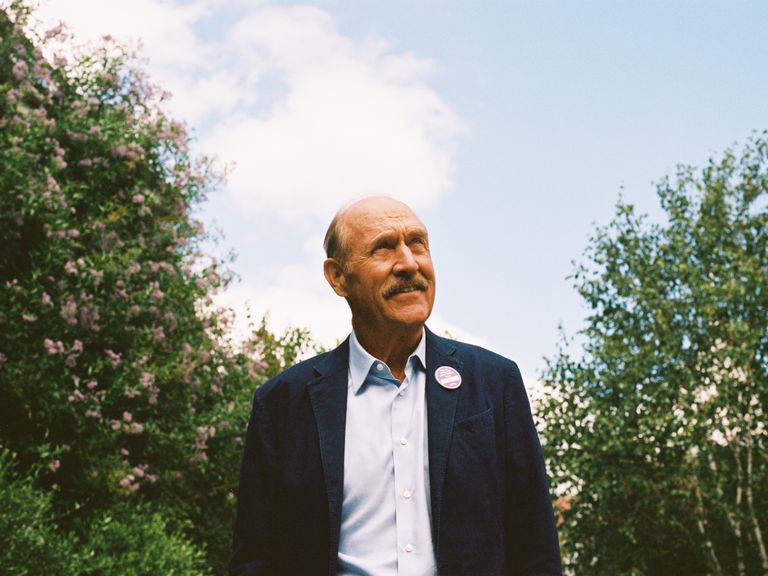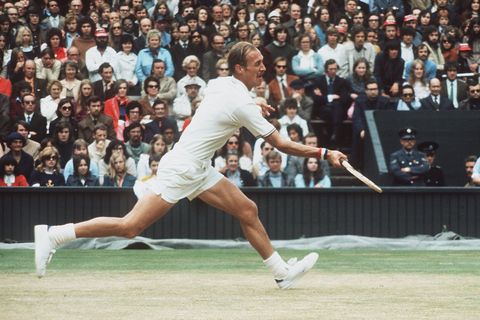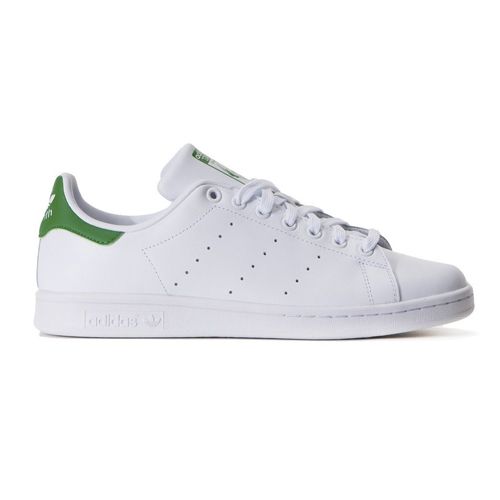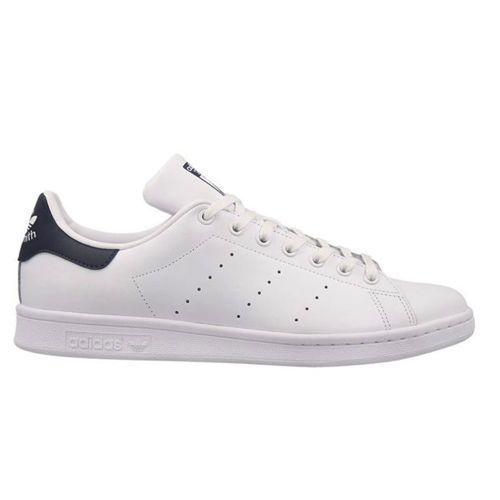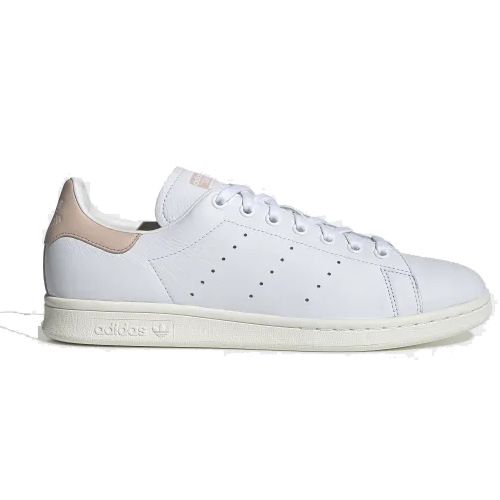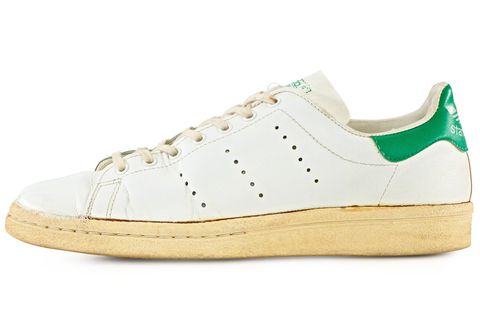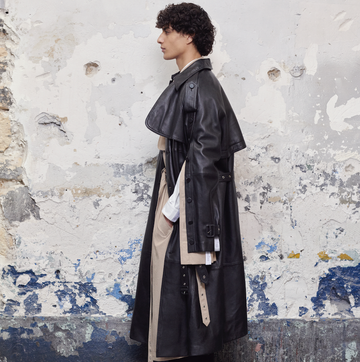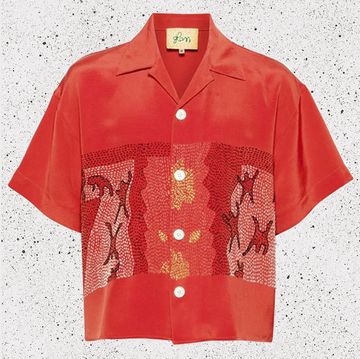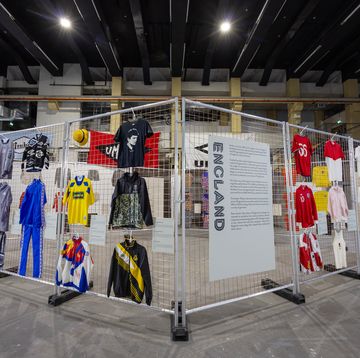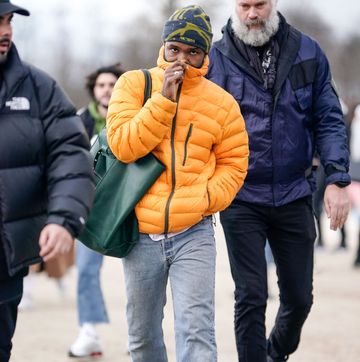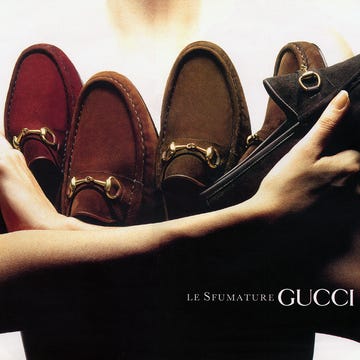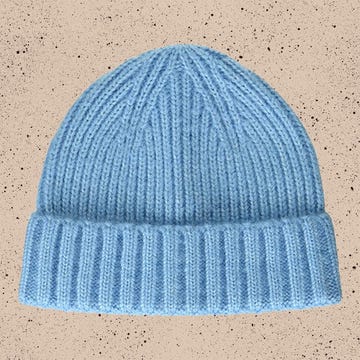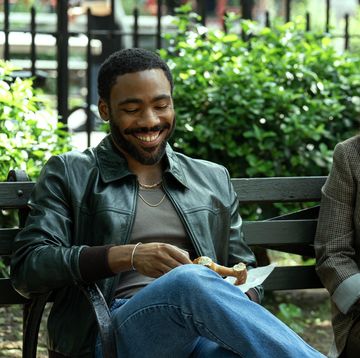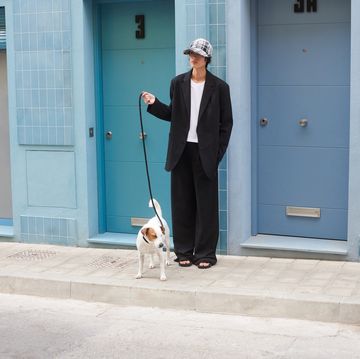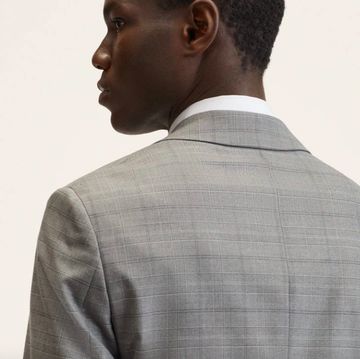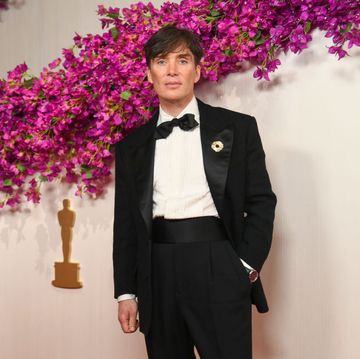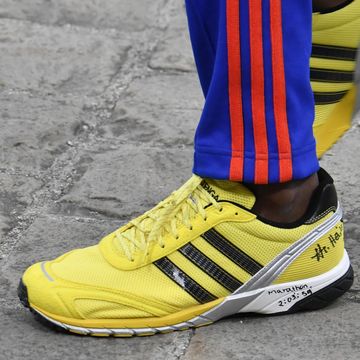“I guess it is pretty weird seeing my face on a pair of sneakers,” Stan Smith says, reclining in his chair, positioned in the shade of this carefully landscaped garden just off Wimbledon Common. The air is sweet with the smell of hydrangeas and expensively-cut grass. A stream of 747s groan above and then beyond us, their strange song echoing faintly across the Heathrow flight path.
The American tennis legend is wearing an immaculate navy blazer and an expensive-looking pale blue shirt. He is tall, six-foot-four, regal in a mellow, California kind of way, with a Roman nose and still blue eyes the colour of a swimming pool before the day’s first splash. The distant memory of a centre parting frames a kind face, deeply tanned from years spent chasing a ball around a court beneath a baking sun.
At 72, the moustache, a long-standing signature, is grey-flecked-with-brown, as neatly kept as the courts across the road at the All England Club. On his feet are a lightly-worn pair of the trainers that bear his name, in black with three Velcro straps in place of laces, his face peering up from the tongue. At the last count he owns 70 to 80 different pairs. “I wish I’d kept the first ones,” he says, somewhat mournfully. “I’d love to show you the original shoe.” He likes classic white but is also fond of black leather and blue suede.
“Do you want to hear something funny?” Smith says. “I was in the Royal Box at Wimbledon three years ago and Hugh Grant, out of nowhere, turns to me and says. ‘You know the first girl I ever kissed, I was wearing a pair of your shoes!?’ I did not know that, but people seem to feel connected to me through this sneaker.”
Hugh Grant is in good company. By conservative estimates the Stan Smith has sold more than 50 million pairs since it was released in 1971, although the actual figure is likely much more, making it the most popular Adidas trainer of all time. This decade-spanning partnership, its seemingly-inexorable success and the unlikely metamorphosis of Stan Smith from ‘very good tennis player’ into Stan Smith ‘sneaker tycoon and friend of Pharrell’ can be attributed to a fair amount of talent and a lot of good timing.
At first, the Stan Smith wasn’t the Stan Smith at all. It was the Robert Haillet, named after a French player who, in 1965, was selected by Horst Dassler, son of Adi, to front up the brand’s burgeoning range of tennis shoes. They were gaining an on-court following thanks to their – at the time at least – high-tech leather upper and herringbone rubber sole, making them far more durable and stable than the canvas models on offer from competitors.
By 1971, Haillet had retired and Horst was looking for a new ambassador to endorse a slightly updated version of the shoe; someone who could help Adidas take on America. It just so happened that as the Frenchman was sent out to pasture (he actually ended up working as a sales rep for the brand), there was a young Californian with deft volleys and a booming serve on the rise.
A, in his own words, “decent” player who was more interested in basketball in his youth, Smith happened to be at the crest of the modern tennis wave, graduating from college and arriving on the tour just as the game turned from amateur to professional in 1968. It was a sweet spot in time where there was money to be made and ample public interest, but before the sustained dominance that the likes of Jimmy Connors, Bjorn Borg and John McEnroe would bring to the sport as it moved into the Eighties.
“My life”, Smith says, “has been marked by good fortune. When I was 16, I had four goals: To be the number one player in America, to win Wimbledon, to win the Davis Cup with the United States, and to become the number one player in the world.”
By the time he was approached by Adidas in 1972, Smith was a four-time Davis Cup winner as well as the number one singles player in the world, having lost the final of Wimbledon in 1971, but winning that year’s US Open. The following year he would go all the way at SW19, stepping out in front of 15,000 people on Centre Court and dispatching the early master of what they now call ‘shithousery’, the infamous Romanian, Ilie Năstase in the final. “I had to realign my goals a bit after that,” Smith says with the flicker of a smile.
The first meeting with Horst Dassler took place at 11pm in a Parisian nightclub during the 1972 French Open. “Horst was famous for having meetings late at night,” Smith recalls. “There were these women in tuxedos and I thought, ‘what am I doing here!?’” By the end of the evening he was, long before the ubiquitous brand tie-ins we see today, in partnership with Adidas. His agent negotiated the picture of his face (ironically taken during a very brief moustache-less period) to appear on the tongue of the shoe, and while the official name change to Stan Smith wouldn’t arrive until 1978, a piece of pop culture history that could never have been predicted was born.
Soon the opponents that Smith faced across the net were wearing shoes bearing his likeness. “I didn’t think it was appropriate for people to beat me with that shoe on.” Smith laughs. “If they were wearing my shoe I think they wanted to beat me even more!” By 1988 Adidas had shifted 22 million pairs.
Smith is full of anecdotes about life as an unlikely pop culture icon, which he delivers with an air of slight bemusement, even after all these years. There’s the man who ran after him in New York to tell Smith that he was, ‘big in the hood.’ The parking attendant who asked for the pair he’d just bought to be autographed, jamming them eagerly through Smith’s car window. Jay-Z name dropped him on his classic album, The Blueprint, and Pharrell Williams wrote the foreword to his 2018 book: Stan Smith ‘Some People Think I’m Just A Shoe.’ Juergen Teller took the portraits illustrating its pages. Stella McCartney and Raf Simons each have premium collaborative versions of the shoe. Kate Moss has appeared embossed on the leather of that iconic tongue. John Lennon was an early adopter.
“Phoebe Philo wearing them was huge, too.” Smith adds, mentioning the former creative head of pre-Slimane Celinè, who acts as a kind of high priestess of cool girl European style and has long-favoured a pair of classic Stans as part of her daily uniform. “They’re huge in Paris,” he says with a knowing nod.
“It’s very comfortable. It's very plain. There are no bells and whistles. Well, they’ve added some bells and whistles over the years.” he says by way of attempting to explain the universal appeal of a trainer that has, with its Kelly-green heel tab, low profile, rounded toe cap and perforated three stripes, remained virtually unchanged since 1971 and yet continues to sell in the millions. “You can wear it with almost anything and it's a pretty good price point too. It gets better with time, some people love to wear them worn, but also some people like to wear theirs crispy. Yeah. crisp and clean.”
“One thing I love to see,” he adds, “is a mother and daughter wearing a pair. You know, most daughters would not be caught dead in the same shoes as their mother, but for some reason they don’t mind when it comes to the sneakers. It still surprises me.”
“The Stan is the highest selling Adidas sneaker for a very good reason.” says Simon Wood, founder of the trainer publication Sneakerfreaker. “It’s the most classic/boring/basic sneaker design of all time as well. That’s no diss either. It takes a lot of humble smarts to be this simple and still look hot.
“Every sneaker company would kill to have a shoe that just sells and sells and sells…”
“I still wear them every day,” Smith says, looking down at his trainers, shuffling in the short grass. “I see it as this global style. It’s huge in Japan. I once had a guy come up to me there and say he’d worn my shoe every day for the last 20 years! I’ve mentioned Paris already, right? I think they see it as a French style because of the Haillet. They still won’t let me wear them in the Royal Box at Wimbledon, though!”
Despite sustained pressure from competitors at every price point (Common Projects has essentially built a very successful business out of making a £300 tennis shoe that looks remarkably ‘Smithian’) and a brief relaunch period back in 2014 that saw it removed from shelves for close to two years to up the scarcity factor - “I remember thinking, oh well, it was a good run, but it’s over.” Smith says of that time - the Stan Smith is still a force after nearly half a century on shelves.
“We have seen the Stan Smith become one of most consistent and best-selling footwear styles over the last six months or so.” says James Trivunovic, buyer at END Clothing. “This is all organic sales growth with no marketing or social media pushes.”
“The shape and aesthetic of the shoe means that anyone can wear it.” Trivunovic adds. “There are no more than a small handful of sneakers out there today that you could say that about.”
Today, Stan Smith the man enjoys the good life. He’s been officially retired since 1985 and lives on Hilton Head in South Carolina with his wife, Marjory. He has four children and 14 grandchildren. He runs his own tennis academy and is the president of the International Tennis Hall of Fame. The serve might not quite be what it used to, “but I still enjoy hitting the ball.” Smith says. “I still play regularly.”
Over a 17-year career in tennis, Stan Smith earned approximately $1.7 million (£1.36million), but with a royalty system in place for his shoes and a lifelong contract with Adidas that he signed in 2018, Stan Smith is a very wealthy man thanks to that 11pm meeting in Paris with the nocturnal heir of the brand with the three stripes.
“At the beginning it was a five-year contract. I never in my wildest dreams expected that I’d have a shoe that sold like this, all these years later.” Smith shakes his head. “I’m 72 now.”
It’s drifting into late afternoon on the first Monday of the Wimbledon fortnight. A lawn mower begins to rev in an adjacent garden, the sound of grass being cut drowning out our conversation. Smith thinks Novak Djokovic is going to win the men’s title again. He still hasn’t met Raf Simons, but he’d like to. Later in the year he’ll travel to Adidas HQ in the tiny Bavarian town of Herzogenaurach to celebrate the company’s 70th anniversary. “I think I’ll be the longest-serving member of staff there!” he says with a grin.
We take a walk around the garden, the man who has appeared on 50 million pairs of trainers gently stooping down to inspect the new and strange variety of flowers he sees along the way.
“You could say I’m happy with how it’s turned out,” Stan Smith says to me as we finish our little lap.
“It all seems to have gone quite well.”
The Stan Smith trainer is part of the Home of Classics collection available here: https://www.adidas.co.uk/home_of_classics
Like this article? Sign up to our newsletter to get more articles like this delivered straight to your inbox
